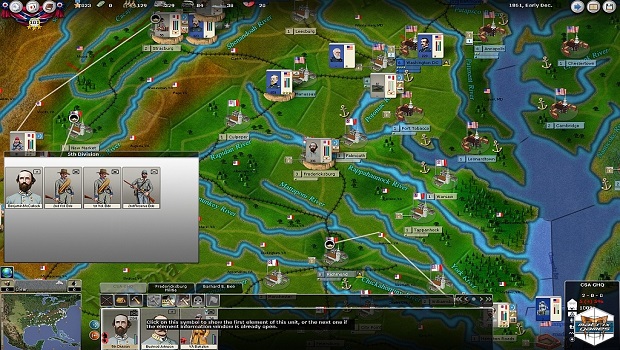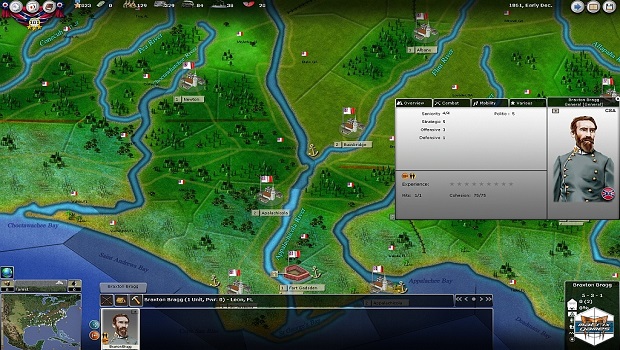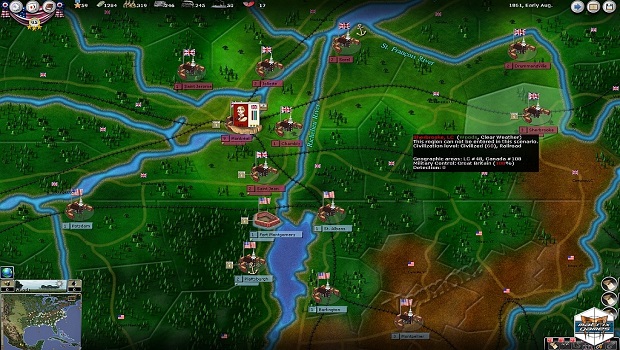Step one for me in playing AGEod’s American Civil War 2 (ACW2) was to print out the nearly 130 page manual.
Now, for those of you who didn’t run and hide after reading that sentence, you’ll find that after investing the time to learn the ins and outs of the game system and mechanics, American Civil War 2 is an engaging, realistic, and entertaining simulation of the War Between The States. I won’t deny the game’s niche status; it requires a serious investment of time and brain power to get into and play well. I also must admit that the game, given the smaller audience, doesn’t have the production budget of more mainstream titles. But for a student of the Civil War, who really wants to dig into why the conflict happened the way it did, why what was assumed by so many to be a short summer affair dragged into more than four years of bloody warfare, ACW2 will provide the defining gaming experience.
The game is played out on a massive map of North America, stretching from Mexico and in to Canada. It is vastly improved over its predecessor, providing a functional view of the entire continent so that you may plan your war effort. It doesn’t quite have the production value of, say, Civilization, or even the recent Paradox efforts. The interface has a dated look, though it does have a lot of more modern accessibility; the copious menus are only a click or hot-key away. The map also includes a large number of overlays, allowing you to easily view, for example, your supply situation with a simple click. Armies appear on the map with a distinct boardgame feel.
Information is, as I said, easily accessed. Armies are portrayed on the map with their strength (“power”) on the counter. Other information, however, is not quite so easily understood. Leaders are rated in three areas; you’ll need the manual to know why having a 1-0-0 leader is REALLY bad. The tutorial is good at explaining the basic mechanics of play, of how to organize your armies and produce units. Those basics aside, you’ll need a deeper understanding in order to actually power your way through the game, understanding which will only come from quality time with the aforementioned manual.
Once you gain that understanding, however, a world of opportunity awaits. You’ll have the challenges of organizing your army, choosing your commanders while balancing the politics of seniority. Sick of Irvin McDowell and George McClellan leading their armies in either disparate, disorganized advances (assuming they advance at all)? Well, you may not be able to remove them unless they suffer a significant defeat, at the risk of harming the morale of the nation. You may (especially as the Union player in the first couple years of the war) find yourself hamstrung by the inability of your leaders. ACW2 is a simultaneous-resolution game; for each two-week turn, you plot out your moves while your opponent plots out theirs, and then watch the results. Your soldiers will attempt to follow your orders. But sometimes, they will be too cautious or slow, and other times they will behave more aggressively than you might have desired. It’s a wonderful balancing act, putting the player in the roll of commander-in-chief, suggesting courses of action, and then watching the armies carry them out within the limits of their own commanders’ genius.
I am a huge fan of this system, as it is one of the few that offers a truly accurate simulation of theater-level command. Histories of the war are filled with cases where Lincoln or Jefferson Davis would badger one of his commanders repeatedly to move. George McClellan was legendary for his ability to ignore direct orders, but numerous other commanders (Rosecrans, Thomas, Bragg, and even Stonewall Jackson) showed a remarkable inability to be where they were supposed to be. Others (Ambrose Burnside being the most well-known example), took their orders too literally, and launched bloody, fruitless headfirst assaults. The game system simulates command by putting the onus of logistics on the player, giving them the opportunity to attempt to put their troops in a position to win, all the while maintaining a natural uncertainty.
I will say that ACW2 is best played via hotseat or email against another person. The AI is competent but seems prone to overreacting to feints. In the 1861 campaign, I was victorious because a slight advance down the Yorktown peninsula caused the Confederates to completely abandon the center of Virginia to my advancing Yankee soldiers. The AI will, however, generally make solid decisions about whether to fight or live to fight, and manage its supply lines and production well. None of this compares to the audacity and unpredictability of another player, of course. Between two experienced generals, ACW2 truly reaches its highest levels.
American Civil War 2 is an excellent game. However, its complexity (which I don’t think could be mitigated by any sort of tutorial) and lack of graphical capability will keep it confined to a niche audience of period fans and hardcore strategy gamers. Once you crack that hard outer shell, you will find an incredibly rich interior with what in my mind is the best simulation of the entire war on the market. Getting there, however, requires an investment only the ardent few will provide.



